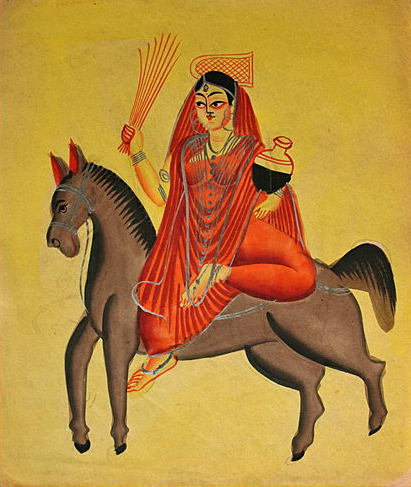SITALA (SHITALA) He who runs towards Bhairava, Bhuta (Ghost) or Sitala, he can only be recipient of the reward of the vehicle of an ass, who rolls up in the dust. , Sitala is the name of the deity, who is supposed to have the charge of that disease i.e. small-pox. She has the vehicle of an ass and is dressed in red clothes. She is worshipped for the protection of persons suffering from small-pox.
References :
1. Kohli,Surindar Singh ed,Dictionary of Mythological References in Guru Granth Sahib 1993
Shitala, also spelled as Sheetala, is a revered goddess in Hindu mythology, primarily worshipped in North India. She is associated with healing, protection against diseases, and cooling relief. Her name, derived from the Sanskrit word Shitala, means “cooling” or “soothing,” reflecting her role in alleviating suffering caused by fever and infectious diseases, particularly smallpox.
Key Aspects of Shitala:
Origins and Mythology:
- Shitala is considered an incarnation of Goddess Parvati, embodying her nurturing and protective aspects. In some traditions, she is linked to Durga or Shakti, emphasizing her divine feminine energy.
- She is believed to protect children from ailments like smallpox, boils, and fevers, and her blessings are sought for family welfare and fertility.
Iconography:
- Shitala is typically depicted riding a donkey, symbolizing humility and her connection to the earth.
- She carries a broom, hand fan, and a water pot filled with medicinal water, representing her ability to cleanse and heal.
- Her serene appearance and cool colors in her attire reinforce her role as a protector against heat-related ailments.
Rituals and Worship:
- Shitala is worshipped during festivals like Sheetala Ashtami, observed on the eighth day of the Hindu month of Chaitra, especially after Holi.
- Devotees offer sweet dishes, rice, and jaggery to her, seeking her blessings for health and protection against diseases.
- Rituals often include bathing in holy rivers and offering prayers to ensure refreshing rainfall and prevent famines.
Symbolism:
- Shitala represents the dual aspects of disease and healing, reminding devotees of the importance of balance and divine intervention in maintaining health.
- Her worship underscores the interconnectedness of physical and spiritual well-being.
Shitala’s significance extends beyond Hinduism, as she is also venerated by Buddhists and tribal communities. Her role as a healer and protector makes her a vital figure in the pantheon of Hindu deities.



